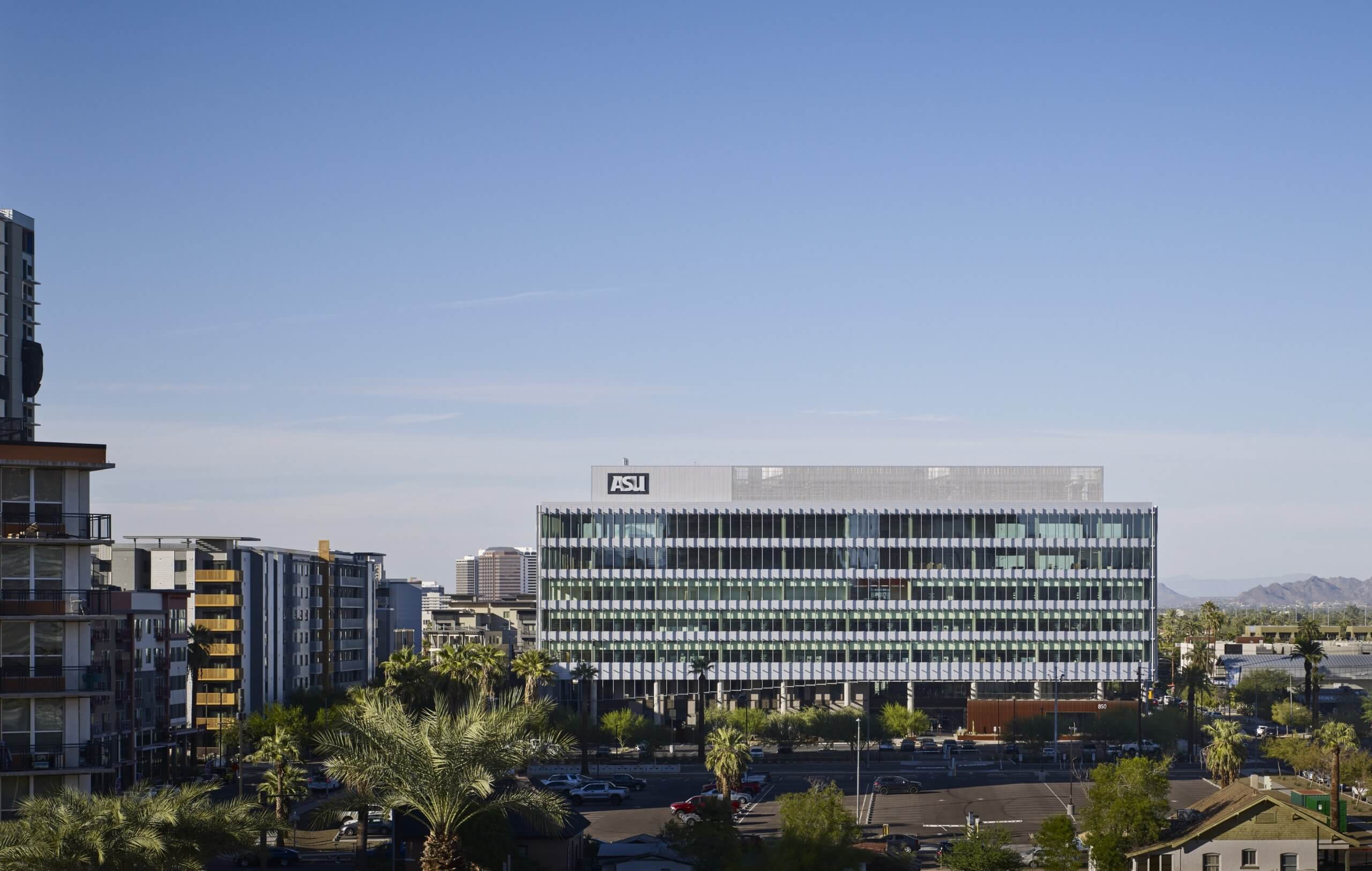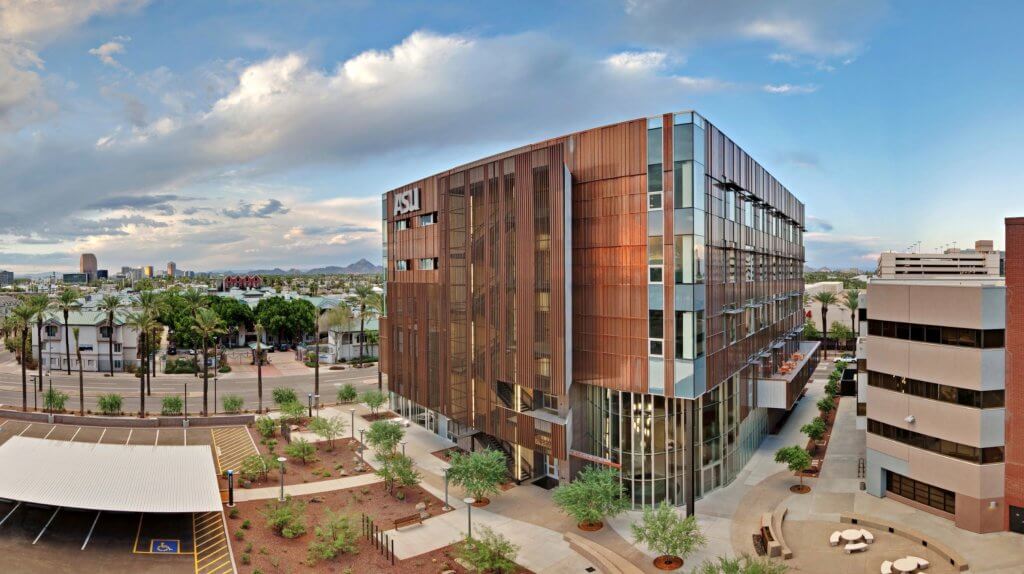In the heart of the Sonoran Desert, where urban sprawl and natural beauty intersect, lies Downtown Phoenix.
This vibrant hub of culture, business, and community is transforming, and architectural firms like HKS, SmithGroup, and Dig Studio are at the forefront of this change. With a commitment to proper practices, innovation, and sustainability, these firms are shaping the future of architecture in Phoenix.
Let’s dive into the significance of architectural excellence with each team’s notable projects and their vision for a green, inclusive, and innovative Phoenix.
HKS Reimagines Downtown Phoenix
The world-renowned firm HKS (Harwood K. Smith) has a long-established branch in Phoenix that played a critical role in the designs of the Phoenix we know and love today.
HKS Director and Principal Mo Stein (A recent subject of Phoenix Community Alliance “City-Shaper” series) and his firm have had an impactful history on the community.
“Architects and designers help shape communities through a multifaceted lens of beauty and performance. Projects are purpose-driven, with many factors influencing the resulting built environments. Some of these factors, which have become a standard amongst professional organizations, are called the 10 Measures of Design Excellence,” said Vice President and Studio Design Leader Chris Jenkins.
A framework created by the American Institute of Architecture (AIA) comprises 10 principles that define “good design in the 21st century.” Such as design for equitable community, which integrates the concept of wellness for communities and equality for all communities.
Another measure is design for ecology, using the natural environment to shape the design and prevent ecosystem destruction.
HKS has applied these principles to contribute to Downtown Phoenix, such as the Firm’s enduring collaboration with the Arizona Diamondbacks and Maricopa County.
“Through the years, we have done many improvement projects at the stadium, including the APS Solar Pavilion on the West Plaza. When MLB implemented increased fan safety protocol and upgraded facility security measures, HKS worked to make those happen at Chase Field (and many other Major League Baseball stadiums and spring training facilities around the country). We helped implement instant replay at Chase Field and have remodeled the business center and many other suites. We also redesigned all the team shops, replaced the scoreboard, and other off-season improvements,” Jenkins said.
Not only does HKS serve the Downtown Phoenix community, but they are also fulfilling the goals of the UN Global Compact right here in our backyard. The UN Global Compact is a voluntary initiative in which businesses and corporations commit to responsible business practices. HKS implements those practices in every project in their portfolio, like the recently built Wexford Science + Technology Building at 850 PBC.
“Wexford 850 PBC is a 240,000 square foot, seven-story research and office building located just south of Roosevelt Street Downtown. The building meets LEED Gold Standards, uses xeriscape landscaping, and is helping to grow the downtown pedestrian infrastructure,” said Jenkins.

The Wexford Science + Technology building at 850 PBC. (Photo: HKS Architects)
SmithGroup Keeps Up the Momentum
SmithGroup is another groundbreaking firm that has helped Phoenix solidify its position as one of the top 5 growing cities in the US.
John Tran, AIA, NCARB, LEED AP, the Vice President and Design Principal of SmithGroup, explains the critical differences between the Phoenix metro area and other cities, “We are a younger city – with an evolving Downtown core.”
With Phoenix growing, the need for education and research facilities has also grown with Phoenix growing rapidly, and the demand for education and research facilities has also increased. SmithGroup has fulfilled this need, and more research facilities have been completed with big things on the horizon.
These labs and the opportunity and innovation that come with them will be a destination point for all levels of schooling in Downtown Phoenix.
“The presence of our academic and research institutions Downtown is huge. ASU and UA’s commitment to Downtown cannot be overstated in their crucial role in defining what Downtown Phoenix will be. Hance Park, the Legacy District, and the incredible opportunity to double down on the laser-focused are the assets we need to build on. We need to remain laser-focused on keeping the momentum going. The expansion plans for the Valley Metro [light rail] are crucial to the connectivity of our Downtown to the rest of the valley,” said John Tran.
“We are seeing a population shift Downtown, with more residents, amenities, and feet on the sidewalk.”
While SmithGroup is helping keep its feet on the sidewalk, they are also set on using sustainability techniques and cutting emissions from large buildings.
“We designed the first NET ZERO building in Arizona, and our commitment to sustainability and innovation is one of our core values. We strive to continue to push ourselves and our clients to think about what’s possible,” said Tran.

ASU College of Nursing and Health Innovation and College of Health Solutions (Photo: Arizona State University)
Dig Studio’s Nature in the City
Dig Studio is comprised of experienced planners, landscape architects and designers capable of delivering everything from complex regional plans to the perfect pocket park. Dig Studio’s design solutions build strong connections between people, nature and the urban environment, creating places where people thrive, together.
For Dig Studio, the landscape design process combines art and science, and is rooted in a deep understanding of how they work together. Their goal for each project is to align the built and natural environment to elevate the experience of a place.
“We work hard to create spaces that can host people in a range of activities and scales, and that work with both larger and smaller crowds. Thoughtful selection of plants and materials creates microclimates, and vertical elements and structures create a sense of enclosure or openness. Hardscape elements, such as pathways and seating areas are strategically positioned to encourage social interaction and relations,” Dig Studio’s Principal, Jay Hicks said.

Civic Space Park in the heart of Downtown Phoenix. (Photo: Dig Studio)
Landscape architecture professionals lead design solutions that result in outcomes that enhance the quality of life in communities and add lasting social, economic and environmental value.
One of Dig Studios’ legacy projects is Civic Space Park. If you’ve walked through Civic Space, you’ve seen the open courtyards that tilt upwards from the center of the walkway and the shade canopies around the park’s edges.
“Topography plays a role in water distribution. The park’s gently sloped terrain naturally directs stormwater runoff, resulting in varying hydration levels for the trees planted at different locations,” states Hicks. “If you walk through Civic Space Park, the trees towards the bottom of the slope are generally larger and greener than the trees towards the top. We go beyond merely considering the total water usage and instead focus on the availability of alternative and naturally occurring water sources.”
When designing a public space, Dig Studio thinks about the space on opening day and the mature space years into the future. They operate on the phrase, “balance year one with year 20.”
“Working with nature teaches you to plan for the future – planning for what a site will look like on day one, and how it will fill in, change and grow over decades,” said Hicks.
Architecture isn’t just about creating and designing; it’s about crafting an artistic and sustainable legacy for future generations.
In the heart of Downtown Phoenix, these firms are spearheading this legacy through their dedication to proper practices, sustainable design, and innovation. As the city’s landscape evolves, HKS, Smith Group, and Dig Studio projects serve as testaments to architectural excellence’s power in creating spaces that enrich lives, embody values, and contribute to a brighter, greener future.
While we may not see the designer’s people in the background, they will shape the skyline and create Downtown Phoenix’s essence.
“[Architects] are artists and engineers working collectively to help create beautiful, successful places.” – Chris Jenkins, Vice President and Studio Design Leader of HKS.




